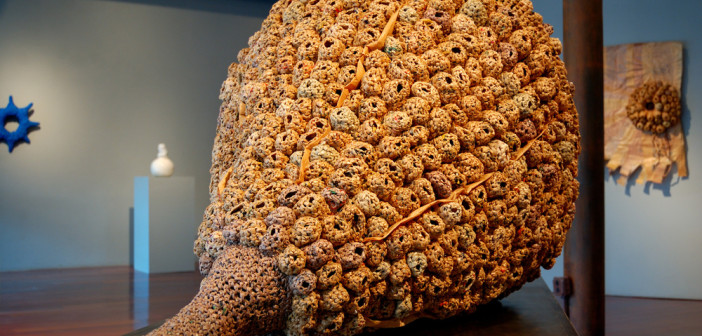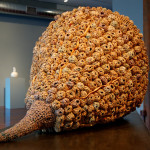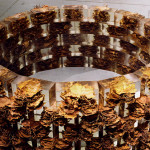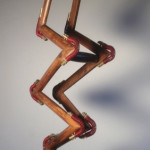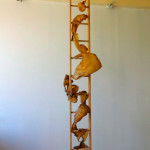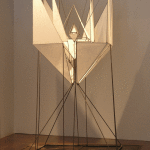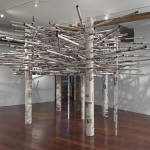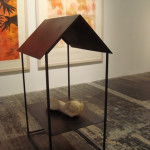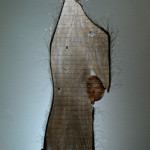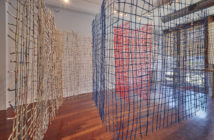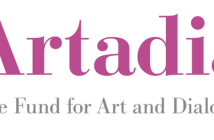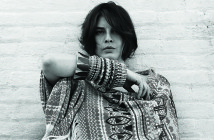20 images projected for 20 seconds each; a speaker with a concise and engaging narrative; an audience. PechaKucha, the Japanese word for the sound of chit-chat, is a popular form of visual presentation, an extended elevator pitch with images, not unlike the successful TED talks. The artists at Boston Sculptors Gallery are choosing to celebrate the collective's 20th anniversary by adapting the model for a series of individual artist talks. Divided into two broad themes, these presentations will take place in the South End on two separate nights this January. The accompanying exhibition opens December 19th and includes the work of 36 current artist-members and 15 alumni.
As a medium and as a word, 'sculpture' has long existed in an expanded field,1 making the Gallery's name seem almost quaint today, as it may have sounded to some in 1992, when it opened its doors. Beyond the allegiance to a specific city, it implies a dedication to the singular object, that takes its place within the protected and pristine confines of an exhibition space, where it can be attentively considered from all angles. The name also chooses to disregard today's overwhelmingly hybrid art practices, ones that weave narrative threads though ideas rather than with media. As with any riddle, there's an answer to be found: until Boston's sculptors banded together and claimed a venue, opportunities to show large-scale work in the city's outdoor and commercial spaces had been few and far between for local artists, with most of the public art commissions going to out-of-towners. Correcting a misperception and drawing attention to equally ambitious work nearby is as good a framework as any for establishing a gallery.
Established, it certainly is. Boston Sculptors, while not the oldest sculpture collective in the nation, is one of the few that continuously have had an artist-operated bricks & mortar space. Boston Sculptors Gallery's nativity story begins in the youth chapel of the Second Church in West Newton. From all I've read, it was a large and cavernous place, challenging to fill and even daunting for some, but hugely empowering for the original 18 artists. During its decade in the suburbs, in spite of the challenge of drawing a public, the gamble to privilege over-sized sculptural work paid off with a number of important local, national and international commissions and exhibitions.
The move to the South End in 2003 (well documented in this article by Marty Carlock) placed BSG directly on Harrison Avenue, alongside many of the Boston's most respected commercial galleries. It hosts two simultaneous solo exhibitions each month and takes part in First Fridays. With the increased visibility came increased rent and a period of significant adaptation for the cooperative. This is where BSG's model of an artist-run space becomes interesting to analyze.
Contrary to assumptions—well, maybe just mine—Boston Sculptors Gallery is a for-profit space. Members pay yearly dues to meet the rent, while overhead—which includes a part-time Gallery Director's salary—is covered by commissions. The income earned from sales has to gross about $100,000-115,000 annually for BSG to break even.2 The biggest prejudice such a space has to fight off is that of privilege (an ability to pay to play) and how that impacts the roster of artists (fewer young artists; less diversity; artists with greater independent wealth or tenured teaching positions.) My first question to member-artist Rosalyn Driscoll touched on this very point. Yes, the rent is considerable, she says. Added to which come the cost of promoting a show and making large-scale work. This is one of the reasons Boston Sculptors has increased the number of members from 20 to 36 since moving into town. An alumnus membership status has also been created recently: in return, alumni are recognized in an annual group show. Members have begun floating initiatives to develop a scholarship for younger artists. Kingston Gallery, Boston's other South End artist-operated gallery, has an emerging artist program that waves membership fees for one year and offers the chosen artist a solo show.
The benefits of being a part of a collective are not negligible. On top of being assured a solo show every other year, a member can count on the support of a peer group and the exponential network of such a collaborative venture. Driscoll says that her reasons for being a member have shifted significantly since joining. Initially, the draw was the regular solo show; now it is all the added exhibition opportunities and exchanges that keep her involved. The Gallery's Blog documents some of these recent projects: last June, the group had a curated exhibition exchange with The Sculpture Center in Cleveland; this May, members' work will be displayed on the Christian Science Plaza downtown until October; and in 2014, a traveling selection will go to Berlin. These opportunities have surfaced through direct outreach from members as much as through personal connections.
Much of the commercial success of an artist depends on the extensiveness of their collector base and the most sought after works are generally those of the artists with the strongest networks. A system has been put in place for the sake of fairness: if an artist's sales exceed $10,000 a year, only 10% goes to the Gallery (a cut significantly lower than most commercial galleries would take). This creates a strong incentive to promote exhibitions and sell work. If sales remain under the $10,000 margin, the cut increases to 30% (still lower than the traditional 40-60%). Furthermore, because BSG artists aren't under contract with a more traditionally commercial space, they have no restrictions on where and with whom else they show.
There are plenty of counter-arguments to defend the boons of a commercial venue and its higher commission, but it is hard to dismiss the freedom and sense of cooperation present in a collective. "Through the committees and in our general meetings every other month, we manage to accomplish a remarkable amount with a remarkable degree of harmony and good will. Any group has the potential for infighting, conflict, power struggles and sabotage, and we are unusually free of that", says Driscoll. The Boston Sculptors certainly made one very smart decision in hiring a part-time Director. The artists take turns sitting at the Gallery and are each responsible for joining various committees that oversee aspects of the business. But Jean Mineo, the current Director, is the central brain of the place, liaising between artists, and providing professional accountability and a continuous link between members, the Gallery (and its brand), the press and the public.
Driscoll sees the potential for more and deeper dialogue between the members and hopes for a longer conversation about what the Sculptors are collectively initiating in Boston: these upcoming PechaKucha nights seem like a good start to changing that. Meanwhile, the anniversary exhibition, opening next week, celebrates the past 20 years by gathering works that consider the passage of time, in the physical and tangible sense as much as in the metaphorical and psychological one. Boston Sculptors Gallery is beginning 2013 in the spirit of reflection.
[1] Rosalind Krauss, Sculpture in the Expanded Field
October, Vol. 8. (Spring, 1979), pp. 30-44.
[2] I owe these numbers to the excellent article by Marty Carlock, Networking the Creative Life.
Further information:
Boston Sculptors Gallery is located at 486 Harrison Avenue, Boston.
The PechaKucha artist talks will take place at 500 Harrison Avenue, with reception to follow in the Gallery.
Saturday 5 January 2013, from 4:30 — 5:45 pm: Traditional and Non-Traditional Sculptural Materials in a Contemporary Context.
Speakers: Baring-Gould, Driscoll, Dodson, Lipsitt, Lyman, Milliken, Pollans, Verlin, Zimmermann.
Wednesday 23 January, 2013 from 6:15 — 7:30 pm: Sculpture that Works with Audience: Kinetic, Interactive, Installation and Public Art.
Speakers: Bagenal, Bernard, Galston, McDaniel, Muhammad, Selvage, Sherman, Svoronos, Wales, Wheelwright.
Further anniversary events include: Convergence, Wednesday 1 May - Thursday 31 October, 2013, on the Christian Science Plaza, Boston
The Gallery produced a catalogue in 2011.
Boston Sculptors Gallery, with an introduction by Marty Carlock
- Michelle Lougee Dinoflagellate, 2011 Plastic bags 55″ × 34″ × 30″
- Beth Galston Sycamore Circle, 2003 Urethane resin, sycamore leaves Dimensions variable
- David Lang Flexible Flyer, 2012 Mixed media, 27″ x 12″ x 8″
- Rosalyn Driscoll Molt, 2012 Wood, rawhide. 144″ x 18″ x 25″
- Andy Zimmerman Paper and Steel Welded steel, paper 94 x 48 x 48 in
- Caroline Bagenal Summer Palace, 2010
- Valdez Holding, 2012 41″ x 18″ x 24″ limestone, metal
- Leslie Wilcox Versceral, 2011 24″ x 12″ x 3″ wood, graphite, fiberglass screen

